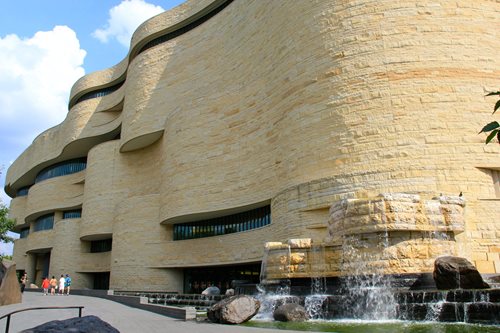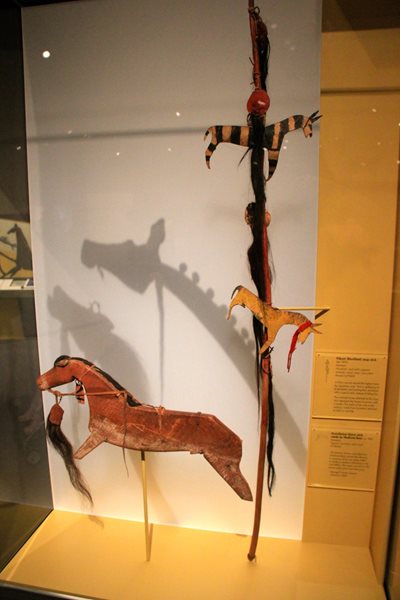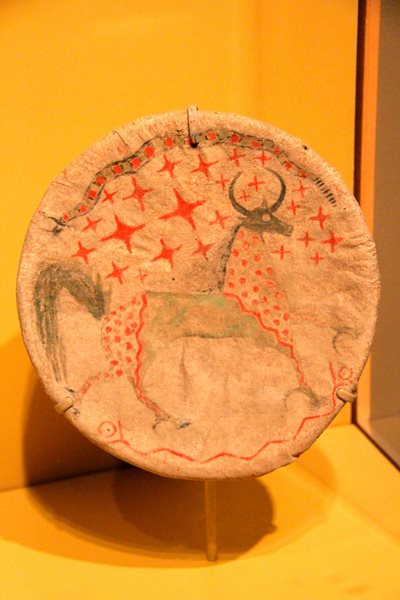A smorgasbord of Smithsonian museums in Washington D.C.
Posted on Jan 01, 2013 in category
James Smithson (1765-1829), an English scientist and illegitimate son of an aristocrat, never visited Washington D.C. yet, he bequeathed his fortune in 1829 to establish an organisation in Washington D.C. to expand and promote knowledge. His original 508,318 pounds has gone a long way - 19 museums and art galleries later, in addition to a National Zoo, the Smithsonian is now a formidable institution.
The National Museum of American History has a huge job and responsibility in presenting to the public the long and varied history of the United States of America in an interesting, enjoyable and knowledgeable way. It must have an enormous collection of priceless artefacts it could display to tell this fascinating mega-layered story. To some extent it is a victim of its vast collection with some exhibitions looking more like a treasure trove in an antique shop. Visitors can't help being overwhelmed by a mountain of incredible examples of historically fascinating bric-a-brac.
.aspx?width=500&height=320)
The only ironic remains of the Alexanders' house in New Orleans after Hurricane Katrina struck the city between 25-31 August 2005. It symbolises both the devastation of the disaster estimated at $100 billion but also the social and economic inequities in New Orleans' communities.

Jim Henson's contribution to children's educational television was 'Kermit the Frog', lead muppet in 'Sesame Street', that first appeared on PBS in 1969. Kermit's display cabinet was positioned oddly next to Art Deco jewellery designed by Paul Flato during the inter-war period.
'America on the Move' is an ambitious thematic exhibition on the history of transportation in the U.S.A. Exhibits vary from the 'Jupiter' locomotive that arrived in Santa Cruz in 1876 linking the town to the new national network to a reconstruction of the 'Oak' ship in New York Harbour. Cars and the growth of the national highway system unsurprisingly play a significant role in this exbihition which is sponsored by some major automobile companies.

A reproduction made in 1913 of a Mandan/Hidatsa bullboat used by tribal women to gather wood. This lonely exhibit in 'America on the Move' recalls 'Buffalo Bird Woman' who paddled one along the Missouri River:
"Near Like-a-Fishhook village, wood was rather scarce because we sold so much of it to steamboats." A problem with this exhibit is there is no important historical context presented to visitors outlining why the tribes sold wood to the paddlesteamers. Interesting but also uncontroversial!
Another temporary exhibition that did impress in terms of its perfect size, the selection of insightful exhibits and importantly, not shrinking from controversy, was 'Slavery at Jefferson's Monticello - Paradox of Liberty'. Paradoxically, the U.S.A. brags both today and generally about its past that it is the land of opportunity, freedom and liberty. However, the era of the American Revolution in the late 18th century, which is epitomised by the Declaration of Independence's catchcry that, 'all men are created equal..', was also an era of ubiquitous slavery. Thomas Jefferson played a significant role in the creation of the Declaration and also in the executive government of the new nation after George Washington's retirement; yet, he owned over 600 slaves who worked on his plantations. Jefferson is on record early in his career pontificating that he found slavery an 'abominable crime', passed anti-slavery laws in Virginia and called for abolition of slavery in the newly gained British Northwest Territory but, post 1785, he remained tight-lipped on the 'cruel war on human nature itself.' (this phrase, written by Jefferson, was later deleted from the Declaration of Independence by Congress!).
Great insights into Jefferson's personality, conditions on his Monticello plantation for his slaves and the personal relationships between Jefferson and his slaves are presented in a concise and fascinating way where viewers are forced to draw conclusions based on very powerful exhibits.

A powerful document - Jefferson's nailery account book. Jefferson's records reveal a fastidious nature. Each slave's daily profit was calculated by recording the number of nails produced from a measured quantity of nailrod and production time. Jefferson was able to judge each slave's proficiency. Other questions come to mind too when studying this document:
- What would it be like to spend 68 days just making nails in a blacksmith workshop?
- Why didn't Jefferson's fine accountancy skills save him from leaving in effect, a bankrupt estate that had to be auctioned, including 130 slaves, to clear his massive debts of $107,000 (over $1 million in today's value)?

Jefferson died on 4 July, 1826 leaving a will that freed only 5 slaves and informally freeing 2 female slaves, Sally Hemings and Wormley Hughes.
Another confronting issue in this exhibition is the relationship between Jefferson and his slaves. DNA testing in 1998 of descendants of Thomas Jefferson's uncle, Field Jefferson, and Eston Hemings, Sally Hemings' son, reveal that a male with a Jefferson Y chromosone fathered Eston Hemings who was born in 1808. Although Jefferson had other relations living in Virginia at the time, the argument is overwhelming that he was the father of Sally Hemings' children. Again, this raises issues about Jefferson's character as he only informally requested Sally's freedom and, what happened to his illegitimate children? A truly model exhibition which owes its origins to the National Museum of African-American History and Culture.
One dramatic exhibit that went over well with visitors was the 'Greensboro Lunch Counter Student Sit-in'. Here a young African-American presenter successfully dramatised the incident with visitors by using role-play techniques.
On February 1, 1960 four African-American students resolved to test the Jim Crow segregation laws in the town of Greensboro, North Carolina. After being refused service in a Woolworths lunch counter, the four students remained in their seats despite the furore surronding them. The protest lasted 6 months as more and more African-American students decided to join the sit-in. For an interesting article on this events see: Courage in Greensboro, North Carolina!

A terrific way to present history in a 'Brown Eyes, Blue Eyes' type of role play.

The presenter was passing around the plate so to speak- Woolworths' very profitable lunch counter menu. After 6 months of bad publicity Woolworths desegregated one of its flagship lunch counters. An original protester, Joseph McNeal, went on to become a Major-General in the U.S. Air Force and as he said, not to confront the problem meant that African-Americans were part of the problem!
Amazingly listed as the 18th. Smithsonian Museum, the National Museum of the American Indian is very striking, golden-rock-like architecture. Designed by a team of indigenous architects and consultants, it is a magnificent symbol of native longevity and creativity.

Cascading water flows over the 'Grandfather Rocks' which symbolise the 'elders of the landscape' and the importance placed by indigenous peoples on cultural and spiritual harmony with their lands.
'A Song for the Horse Nation' exhibition traces the important life-changing relationship between the American Indians and the reintroduction of horses on to the American continent by Spaniards during Columbus' second voyage in 1493.
Life for tribes living on the Great American Plains significantly improved with the capture and training of horses. Hunting the vastly roaming buffalo herds became more manageable in the early 1800's. There was now more time for cultural and spiritual matters. The trading of guns and other supplies with white fur traders added at first, to material gain. However, after the Lousiana Purchase in 1804, the notion of 'Manifest Destiny' of the American Nation - the divine right to civilise 'savage', un-Christian peoples - coupled with the incessant intertribal Indian warfare due to diminishing buffalo numbers, led to much conflict between Indian Plains nations and the U.S. government throughout the 19th century.

Horse trading was serious stuff within and among Indian tribes!

Proof of intertribal warfare with the owner of this Minnicoujou Lakota tipi bag (circa. 1885) displaying his conquests: horses, possibly a wife and seven enemies' heads during his three war parties - depicted by three black and brown pipes.

Hunkpapa Lakota dance sticks reveal the importance of warriors' steads. The bottom dance stick was created by 'No Two Horns' who fought at the Battle of Little Bighorn in 1876. His horse suffered six separate wounds as depicted by the red triangles and the honour scalps also decorate it.

The longer stick is a Piikuni or Blackfeet 'coup stick'. Warriors could gain great prestige by touching enemies sometimes armed with a 'coup stick'. Also on display is a Assiniboine dance stick owned by Medicine Bear and dated circa. 1860. It honours one of his favourite ponies that was killed in battle during the mid-1800's. The hair used was from that pony.

A messenger horse of the 'Thunder Beings' gallops through a sky that's studded with lightning, hail and stars. This Hunkpapa Lakota medicine shield (circa. 1870's) helped bring summer rains.
To review an excellent online exhibition of 'A Song for the Horse Nation' see: 'A Song for the Horse Nation' online exhibition